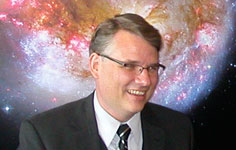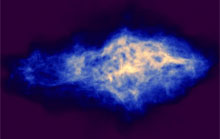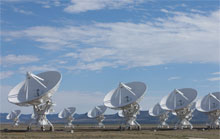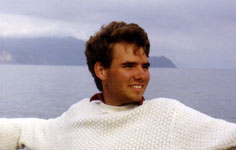
Dr. Kevin Marvel (2008)

A Very Large Array image of the supernova remnant 3C 58 at a wavelength of 20 cm. Credit: M. F. Bietenholz (Hartebeesthoek Radio Observatory & York Univ.); NRAO/AUI/NSF.

The NRAO Very Large Array near Socorro, New Mexico.

Kevin Marvel (1988)
The NRAO Summer Student Program:
Celebrating Five Decades of Training Young Scientists
Dr. Kevin Marvel
Executive Officer, American Astronomical Society, Washington, D.C.
NRAO Summer Student: 1988, Socorro
NRAO Mentor: Miller Goss
NRAO Project: "The Supernova Remnant 3C 58"
Education:
Ph.D., Astronomy, New Mexico State University
B.S., Astronomy, University of Arizona
My NRAO summer student experience solidified my decision to enter research astronomy and exposed me to the world's premier radio astronomy facility. I learned data reduction and the physics underlying many of the astronomical objects studied with radio telescopes. NRAO staff, students, and visitors gathered each day at 3 pm for coffee and to talk about science and technical work, and these conversations taught me a great deal. We also enjoyed colloquia by research astronomers from around the world, informal Tuesday lunch talks, and a fantastic summer student lecture series.
Being an NRAO summer student taught me about science and what it was to do science as a career. This experience continues to inform what I do today, e.g., when I explain to members of the U.S. Congress the value of new and expensive research tools, such as the Atacama Large Millimeter/submillimeter Array (ALMA) and the James Webb Space Telescope (JWST).
I applied to the NRAO summer student program in 1988. I had become involved in research with Ramesh Narayan as a University of Arizona undergraduate, and he wrote my letter of recommendation. It was a memorable mid-spring day when I learned that I had been accepted for the summer student program at the Very Large Array. This would be my first chance to work in astronomy!
My NRAO mentor was Miller Goss, who guided me through a project involving the supernova remnant, 3C 58. Miller had observed HI absorption against 3C 58 with the Westerbork Synthesis Radio Telescope, and these data needed to be calibrated and transformed into images. This work provided an excellent introduction to radio wavelength spectroscopy, imaging, and a range of software tools, and I was pleased to see my work acknowledged in the published paper (A&A, 1993, 274, 427).
The summer students traveled together across the Southwest U.S., visiting observatories while also drinking in the vast expanses and enjoying the region’s food (#7 blue green chicken, please!). I met and became friends with senior and junior researchers, as well as colleagues my own age, many of whom I interact with to this day. Most of the 1988 NRAO summer student class went on to PhDs in astronomy and further study of the Universe at radio wavelengths, including myself. My summer roommate, Ed Murphy, e.g., did his PhD using NRAO telescopes in Green Bank and is now at University of Virginia.
After my NRAO summer student experience, I received a summer (winter) studentship in Sydney at the CSIRO Epping facility working with pulsar astronomer Dick Manchester. I conducted research with the Australian Telescope National Facility (ATNF) and the 64m Parkes Observatory dish.
Graduate school took me to the New Mexico State University in Las Cruces. I returned to the NRAO as a pre-doc working with Phil Diamond on water masers, and I completed my Ph.D. with the Very Long Baseline Array (VLBA) in 1996. A post-doctoral position at the Owens Valley Radio Observatory followed, and two years after that I took a public policy position at the American Astronomical Society (AAS). I became the AAS Executive Officer in 2006 and am still enjoying this complex, ever-changing job, looking after the financial, political and scientific interests of the largest member organization for astronomy in North America.
